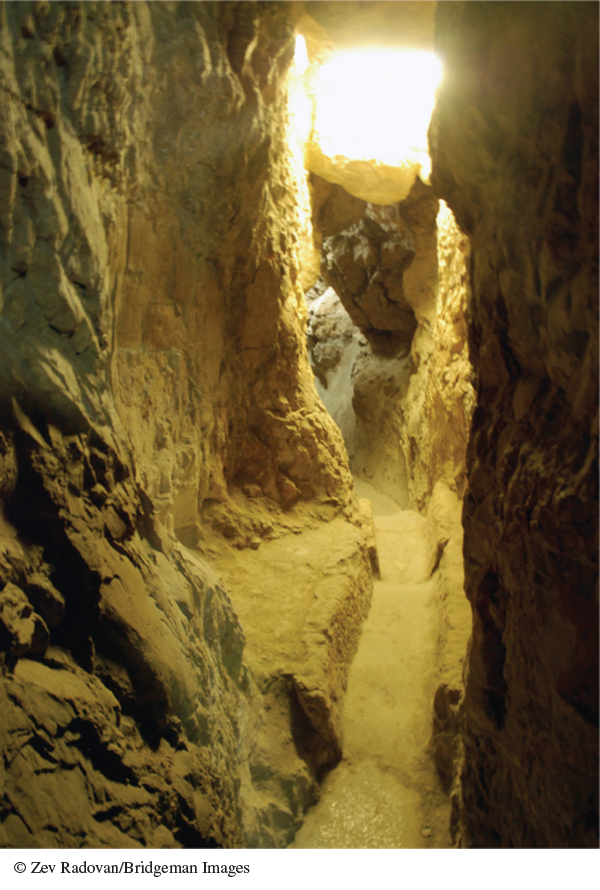A History of Western Society: Printed Page 46
A History of Western Society, Value Edition: Printed Page 43
A History of Western Society, Concise Edition: Printed Page 46
Assyria’s Long Road to Power
The Assyrians had inhabited northern Mesopotamia since the third millennium B.C.E., forming a kingdom that grew and shrank in size and power over the centuries. They had long pursued commerce with the Babylonians in the south, and the peoples of northern Syria and Anatolia in the north. During the time of Sargon of Akkad, they were part of the Akkadian empire, then independent, then part of the Babylonian empire under Hammurabi, then independent again (see Chapter 1). Warfare with the Babylonians and other Near Eastern states continued off and on, and in the thirteenth century B.C.E., under the leadership of a series of warrior-
The eleventh century B.C.E. — the time of the Bronze Age Collapse — was a period of instability and retrenchment in the Near East. The Assyrians did not engage in any new wars of conquest, but remained fairly secure within their borders. Under the leadership of King Adad-
Assyrian history is often told as a story of one powerful king after another, but among the successful Assyrian rulers there was one queen, Shammuramat, whose name in Greek became Semiramis. She ruled with her husband and then as regent for her young son in 810–806 B.C.E. Although not much can be known for certain about the historical Queen Semiramis, many legends grew up about her, which were told throughout the ancient Near East, and later by Greek and Roman authors. Some emphasized her wisdom, beauty, and patronage of the arts, while others portrayed her as a sex-
Eighth-
Assyrian methods were certainly harsh, but in practical terms Assyria’s success was actually due primarily to the size of its army and the army’s sophisticated and effective military organization. By Sargon’s time, the Assyrians had invented the mightiest military machine the ancient Near East had ever seen, with perhaps seventy thousand men in the field in an era that typically saw armies of under ten thousand. The mainstay of the Assyrian army was the infantryman armed with an iron spear and sword and protected by helmet and armor. The Assyrian army also featured archers, some on foot, others on horseback, and still others in chariots — the latter ready to wield lances once they had expended their supply of arrows. Some infantry archers wore heavy armor. These soldiers served as a primitive field artillery whose job was to sweep the enemy’s walls of defenders so that others could storm the defenses. Slingers (warriors who used slingshots) also served as artillery in pitched battles. For mobility on the battlefield, the Assyrians organized a corps of chariots.
Assyrian military genius was remarkable for the development of a wide variety of siege machinery and techniques, including excavation to undermine city walls and battering rams to knock down walls and gates. Never before in the Near East had anyone applied such technical knowledge to warfare. The Assyrians even invented the concept of a corps of engineers, who bridged rivers with pontoons or provided soldiers with inflatable skins for swimming. And the Assyrians knew how to coordinate their efforts, both in open battle and in siege warfare. Assyrian king Sennacherib’s (r. 705–681 B.C.E.) account of his attacks on the kingdom of Judah, which was under the leadership of King Hezekiah (r. ca. 715–686 B.C.E.) in 701 B.C.E., provides a vivid portrait of the Assyrian war machine:
As to Hezekiah, the Jew, he did not submit to my yoke, I laid siege to 46 of his strong cities, walled forts and to the countless small villages in their vicinity, and conquered them by means of well-
What Assyrian accounts do not mention is that the siege of Jerusalem was not successful. Although they had conquered many cities in Judah, the Assyrian armies gave up their attempts to conquer the entire kingdom and went home.
Sennacherib’s campaign is also recorded several times in the Hebrew Bible, but there the point is very different. Instead of focusing on Assyrian might, the author stresses King Hezekiah’s reliance on Yahweh. The biblical accounts attribute Judah’s ability to withstand the Assyrian siege to an angel sent by Yahweh, but they also describe Hezekiah as taking practical measures to counter the Assyrian invasion. He “made weapons and shields in abundance,” and also ordered the building of a tunnel that would divert water from the springs outside the walls of Jerusalem into the city, thus both limiting the water available for Assyrian troops and assuring the city of a steady supply:
When Hezekiah saw that Sennacherib had come and intended to fight against Jerusalem, he planned with his officers and his mighty men to stop the water of the springs that were outside the city; and they helped him. A great many people were gathered, and they stopped all the springs and the brook that flowed through the land. (2 Chronicles 32:2–4)
The tunnel was completed and functioned, and is now a major tourist attraction. An inscription that was originally on the wall recording the way in which it was built has been dated to the eighth century B.C.E., and chemical analysis confirms this dating.
